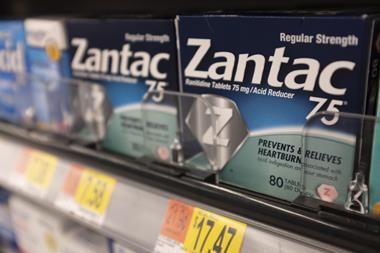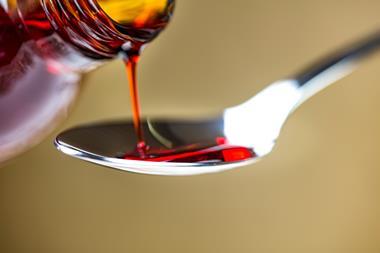Investigation uncovers the cause of contamination in sitagliptin medicines, but the wider nitrosamine problem is ballooning
US drug giant Merck & Co has found the cause of nitrosamine contaminants in three blockbuster diabetes drugs containing the active ingredient sitagliptin. Nitrosamine impurities have the potential to cause cancer, and have come under increasing scrutiny from regulators after their detection in a variety of drugs in recent years.
Merck confirmed it has submitted its findings concerning Januvia (sitagliptin), Janumet (sitagliptin with metformin), and Steglujan (ertugliflozin with sitagliptin) to the relevant authorities. The specific nitrosamine, 7-Nitroso-3-(trifluoromethyl)-5,6,7,8-tetrahydro[1,2,4]triazolo-[4,3-a]pyrazine, or NTTP, ‘was formed during product manufacturing and, predominantly, during subsequent storage of the drug product’, the spokesperson says. ‘The company has already instituted additional quality controls and expects to be able to consistently reduce NTTP levels to meet the long-term acceptable daily intake level this year, although the specific timeframe will be based on the progress of timing to institute process modifications and on engagement with global health authorities,’ they add.
The problem with Merck’s drugs emerged in August 2022. At that point, the US Food and Drug Administration (FDA) agreed to temporarily allow higher NTTP levels to avoid shortages. The company had monitored the products since July 2022 ‘to ensure all batches meet the agreed-upon interim acceptable daily NTTP limit over the course of the product shelf life’.
Sebastian Schmidtsdorff, deputy head of the quality unit at Berlin, Germany-based chromatography specialist Chromicent, and colleagues, had published a method for analysing nitrosamines in sitagliptin–metformin combinations like Janumet in April 2021. That was because metformin, a nitrogen-rich compound like sitagliptin, was one of the first drugs to show nitrosamine contamination, rather than them previously seeing any obvious problem with sitagliptin.
Based on his experience with nitrosamine contaminants, Schmidtsdorff notes that intake limits like the revised FDA levels depend strongly on molecular structures. Nitrosamines don’t cause cells to mutate and potentially become cancerous until after they are activated by cytochrome P450 enzymes in our cells. How well their molecular structure fits into those enzymes significantly affects the nitrosamines’ mutagenic potential. Bulky nitrosamines may have higher acceptable intake levels or not be mutagenic at all.
Some active substances that contain secondary amines appear particularly vulnerable to this reaction
The Merck spokesperson asserts that the temporarily relaxed limits are safe. ‘Our scientific and medical risk assessment found that there is negligible risk to patient safety, including to patients who have taken these medicines for many years, with the current levels of NTTP,’ they say. ‘We continue to work expeditiously on enhancing our controls to further minimise NTTP levels to meet the long term acceptable daily intake level.’
However, Schmidtsdorff stresses that there is currently a widespread issue with nitrosamine impurities related to drug substances (rather than those derived from solvents or other ingredients). Compounds containing amines and conjugated nitrogen-rich systems are typically most affected. About 20–30% of all drugs and their intermediates could form nitrosamines, Schmidtsdorff estimates.
A spokesperson for the European Medicines Agency adds that scientists think nitrosamines form when amine groups in the active drug substances and trace nitrite impurities in other ingredients within the formulation react during manufacturing. ‘Some active substances that contain secondary amines appear particularly vulnerable to this reaction,’ they say. ‘Some cases involving active substances with tertiary amines or other related structural features have also been observed.’
Coordination needed
Owing to the huge number of drug substances that could be affected by nitrosamine impurities, Chromicent is ‘currently facing a flood of requests from [manufacturers] and follow-up investigations from regulatory authorities,’ Schmidtsdorff reveals. Analytical labs are unable to process all the samples on time, he says. To help speed up the process, Schmidtsdorff and colleagues’ 2021 paper details a supercritical fluid chromatography–tandem mass spectrometry method that they suggest could be a universal technique for finding problem substances. The team has shared the method as freely as possible to try to ensure that issues are resolved swiftly.
‘Our hope is that the association of official control laboratories will take on a stronger leadership and coordination role for the analytical part,’ Schmidtsdorff says. ‘Freely available and already validated methods should be published, which would then only have to be transferred or revalidated.’ The EMA spokesperson suggests that already ‘regulatory testing labs around the world have been sharing information on analytical methods with each other and making this available to [manufacturers]’.
Contacted by Chemistry World, the FDA alludes to the fact that these impurities are being discovered mainly thanks to improved analytical techniques. ‘We continually gain new knowledge about drugs which allows us to identify and quickly address previously unknown risks to patients,’ a spokesperson says. ‘When we identify drug quality lapses that pose potential risks for patients, we make every effort to understand the issues and provide our best recommendation to the public as quickly and accurately as possible. We will continue to investigate and work to ensure these types of impurities do not exceed acceptable limits so that patients can continue taking their medicines without concern.’
References
S Schmidtsdorff et al J. Pharm. Biomed. Anal., 2021, 197, 113960 (DOI: 10.1016/j.jpba.2021.113960)


















No comments yet